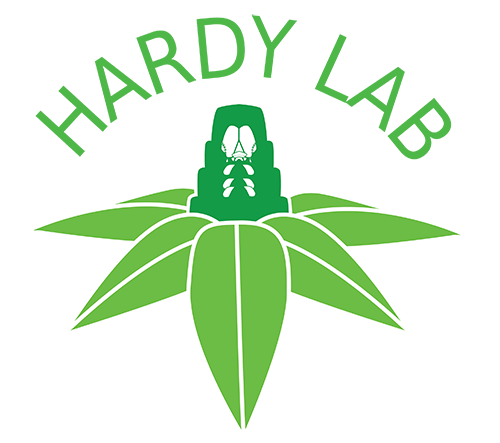Valid Names Results
Pulvinaria floccifera (Westwood, 1870) (Coccidae: Pulvinaria)Nomenclatural History
- Coccus flocciferus Westwood 1870: 308. Type data: ENGLAND: on Camellia sp., and NETHERLANDS: Utrecht, on Camellia sp.. Syntypes, female, Type depository: Oxford: Hope Entomological Collections, University Museum, England; accepted valid name Notes: 15 Unmounted female and 3 male syntypes are available at the Natural History Museum, Oxford, UK (Yair Ben-Dov, visit at OXUM, on December 15, 2002). Tanaka & Amano (2007a) reported that they have slide-mounted 5 adult female from the unmounted syntypes; all syntypes are deposited at the Natural History Museum, Oxford, UK.
- Pulvinaria floccifera (Westwood, 1870); Green 1897: 72. change of combination
- Pulvinaria floccosa (Westwood, 1870); Newstead 1900a: 26. misspelling of species epithet
- Lecanium (Coccus) ochnaceae Kuwana 1909: 154. Type data: JAPAN: Tokyo, on Eurya ochnacea.. Syntypes, female, Type depository: Ibaraki-ken: Insect Taxonomy Laboratory, National Institute of Agricultural Environmental Sciences, Kannon-dai, Yatabe, Tsukuba-shi, (Kuwana), Japan; junior synonym (discovered by TanakaKa2022a, 443).
- Coccus ochnaceae (Kuwana, 1909); Sasscer 1911: 67. change of combination
- Pulvinaria camelicola; Lindinger 1912b: 92. incorrect synonymy (discovered by TanakaKa2022a, 438).
- Pulvinaria linearis; Lindinger 1912b: 92. incorrect synonymy (discovered by TanakaKa2022a, 438).
- Pulvinaria okitsuensis; Kuwana 1914. misidentification
- Lecanium ochnaceae Kuwana, 1909; Kuwana 1917a: 172. change of combination
- Chloropulvinaria floccifera (Westwood, 1870); Borchsenius 1952: 300. change of combination
- Pulvinaria ochnaceae (Kuwana, 1909); Takahashi 1955b: 70. change of combination
- Chloropulvinaria ochnaceae (Kuwana, 1909); Borchsenius 1957: 220. change of combination
- Pulvinaria okitsuensis; Kawai 1972: 16. misidentification
- Pulvinaria floccifera (Westwood, 1870); Ben-Dov 1993: 261. revived combination (previously published)
- Pulvinaria ochnaceae (Kuwana, 1909); Ben-Dov 1993: 273. revived combination (previously published)
- Pulvaria floccifera; Ülgentürk & Hocaali 2019. misspelling of genus name
Common Names
- cottony camellia scale BenDov1993 Gill1988
- Pulvinaria Lloren1990
- camellia soft scale AbdRabEv2021
- Okitsu-wata-kaigaramuchi TanakaKa2022a
- chermes du camélia KondoWaGa2022a
- cocciniglia cotonosa KondoWaGa2022a
- escama blanda algodonosa de las camelias KondoWaGa2022a
- katjiepiering pulvinaria KondoWaGa2022a
- prodolgovataya podushechnitsa KondoWaGa2022a
- حشرة الكاميليا الرخوة AbdRab2012
Ecological Associates
Hosts:
Families: 11 | Genera: 12
- Aquifoliaceae
- Ilex aquifolium | Steinw1946
- Ilex spinigera | MoghadWa2024 | (=Ilex hyrcana)
- Celastraceae
- Euonymus japonicus | Steinw1946
- Cupressaceae
- Chamaecyparis | Steinw1946
- Ericaceae
- Vaccinium vitis-idaea | JansenAl2023
- Pentaphylacaceae
- Cleyera japonica | Kuwana1909a Sassce1911 TanakaKa2022a | (= Eurya ochnacea)
- Eurya | TanakaKa2022a
- Eurya emarginata | TanakaKa2022a
- Eurya japonica | TakahaTa1956 TanakaKa2022a
- Pittosporaceae
- Pittosporum tobira | Malump2013a Steinw1946
- Rosaceae
- Mespilus germanica | MoghadWa2024
- Sapindaceae
- Acer palmatum | KakhkhSo2025
- Acer pseudoplatanus | DervisDrGr2024 DervisDrGr2024
- Schisandraceae
- Illicium anisatum | TanakaKa2022a
- Taxaceae
- Taxus | JansenAl2023
- Theaceae
- Camellia | Ali1971 Balach1939 Green1925b Kozar1986 TanakaKa2022a
- Camellia sinensis | MoghadWa2024
Foes:
Families: 7 | Genera: 9
- Aphelinidae
- Coccophagus lycimnia | DervisStMi2024
- Coccophagus piceae | DervisStMi2024
- Chamaemyiidae
- Leucopomyia silesiaca | DervisDrGr2024
- Chrysopidae
- Chrysoperla carnea | DervisDrGr2024
- Coccinellidae
- Exochomus quadripustulatus | DervisDrGr2024
- Harmonia axyridis | DervisDrGr2024
- Cordycipitaceae
- Lecanicillium lecanii | MoghadWa2024
- Encyrtidae
- Blastothrix longipennis | DervisStMi2024
- Metaphycus dispar | DervisStMi2024
- Metaphycus insidiosus | DervisStMi2024
- Sapindaceae
- Acer negundo | DervisDrGr2024
Geographic Distribution
Countries: 9
- Algeria | KhaladBoMa2024
- Canada | Cocker1896k Green1907 Mamet1943a
- British Columbia | Steinw1946
- France | Steinw1946
- India | Green1900c Green1907
- Japan | Kuwana1917 Sassce1911
- Serbia | DervisDrGr2024
- Trinidad and Tobago
- Trinidad | Green1900c
- United Kingdom
- England | Newste1900a
- United States
- California | Hodgso1994a Steinw1946
- Oregon | Steinw1946
Keys
- DasPrDa2025: pp.578-579 ( Adult (F) ) [Species of Pulvinaria found in India]
- MoghadWa2024: pp.77 ( Adult (F) ) [Species of Pulvinaria in Iran]
- TanakaKa2022a: pp.447-448 ( Adult (F) ) [Pulvinaria species in Japan]
Remarks
- Systematics: Subfamily: Coccinae A, Pulvinarini (Choi & Lee, 2019) Tanaka & Amano (2007a) redescribed and illustrated the adult female, based on syntype specimens. Tanaka & Amano (2007a) showed that previous redescriptions and illustration of adult female - by Ezzat & Hussein (1969), Williams & Kosztarab (1972), Hamon & Williams (1984), Kosztarab & Kozar (1988), Gill (1988), Hodgson (1994a), Granara de Willink (1999) and by Hodgson & Henderson (2000) - were not based on type material, and differed in some taxonomic characters from the 2007 redescriptions. Tanaka and Amano (2007a) did not determine which species had been misidentified as P. floccifera because of the difficulty of obtaining the type specimens of the species synonymized with P. floccifera. This situation subjectively invalidated the identity of P. floccifera. Because two or more species have been studied under the same (inappropriate) scientific name in the absence of type fixation, Tanaka & Kamitana determined that there was an urgent need to determine the misidentified species, or give another name to it/them, and to designate a lectotype of P. floccifera. This enables the separation of the misidentified species from the true P. floccifera, fixes its taxonomic identity and so restores nomenclatural stability. Abdel-Razak, et al., found that P. urbicola can be separated from P. floccifera by lacking submarginal tubercles (7-9 in P. floccifera) and by the 2 subapical seta located in the anal plate (3 in P. floccifera). Pulvinaria floccifera can be separated from P. camelicola in having (contrasting character states in P. camelicola in parenthesis): (i) Type III ventral tubular ducts on head few, marginal to submarginal (Type III ventral tubular ducts absent from head); (ii) dorsum without tubular ducts and dermal areolations (dorsum with a considerable number of dorsal tubular ducts and well-developed large dermal areolations). (Tanaka & Kamitani, 2022a)
- Structure: Dermal areolations absent; dorsal setae spiniform; preopercular pores consisting of a group of 48-83 pores in front of anal plates; dorsal tubular duct absent; marginal setae with frayed, bifurcate, or sharply pointed apices; pregenital disc-pores each with 4-8 (usually 7) loculi; spiracular dis-pores each with 5 loculi; 3 types of ventral tubular ducts; legs well developed each with tibio-tarsal articulation and articulatory sclerosis; antennae each with 6-8 (usually 8) segments. (Tanaka & Amano, 2007a) Live adult female elongate oval, more or less convex dorsally. Body yellow to yellowish green on dorsum. Dorsum without visible wax secretion before oviposition. Ovisac relatively long and flat, about 3–6 times as long as body; posterior part of body not strongly uplifted by ovisac. Slide-mounted adult female: Body elongate oval, 2.9 (1.9–3.9) mm long, 1.3 (0.9–2.7) mm wide, margin with a slight indentation at each stigmatic cleft and sometimes also near each eyespot; anal cleft approximately 1/6 (1/5–1/8) of body length. (Tanaka & Kamitani, 2022a)
- Biology: Takahashi (1955e) noted in Japan that generally one annual generation is developed, however two generations develop on Eurya at Tokyo.
- Economic Importance: The species is one of the most important pests of tea (Camellia sinensis) gardens in northern Iran (Moghaddam & Watson 2024).
- General Remarks: Lectotype designated in Tanaka & Kamitani, 2022a: collected 1870 on Camellia sp. by J.O. Westwood. 4 adult female paralectotypes also designated. Based on this information, it will take some time to identify which hosts, associates and location data need to be transferred to each of the species. We have done this to the best of our ability, but more taxonomic study is to be done. Therefore, some of this catalogue is unreliable at this time. (Barb Denno, March 18, 2022)
Illustrations
Citations
- AbdRab2012: distribution, list, 607
- BenDov1993: catalog, 273-274
- Borchs1957: biological control, description, distribution, host, life history, taxonomy, 220
- BouharChQe2025: natural enemies, 9
- Brick1909a: dispersal, list, 7
- DasPrDa2025: key, 579
- DervisDrGr2024: biological control, natural enemies, 254-257
- DervisStMi2024: natural enemies, 3,19,20,21,22,23
- Fernal1903b: catalog, 132-133
- GiurcaToMu2024: economic importance, taxonomy, 303
- Green1900c: description, distribution, host, illustration, taxonomy, 7-8
- Green1907: distribution, host, 199
- Green1925b: distribution, host, 518
- Hellri2004: distribution, host, 86
- Hodgso1994a: description, distribution, host, illustration, taxonomy, 175-178
- JansenAl2023: dispersal, host, 32
- KahrerHo2024: diagnosis, taxonomy, 233-234
- KakhkhSo2025: distribution, ecology, host, survey,
- Kawai1980: description, distribution, host, taxonomy, 150
- KaxxorSoZa2025a: history, 130
- KhaladBoMa2024: distribution, species richness, survey,
- KondoWa2024: distribution, 2
- KozarWa1985: distribution, 76
- Kuwana1909: taxonomy, 154
- Kuwana1917a: distribution, 174
- Malump2013a: distribution, ecology,
- MoghadWa2024: diagnosis, distribution, economic importance, history, host, natural enemies, 12, 15, 82-84
- Newste1903: distribution, host,
- Sassce1911: distribution, host, 67
- SchuhMo1948: distribution, host, 38
- Steinw1946: description, distribution, host, illustration, taxonomy, 6-7,19
- Takaha1955a: distribution, host, taxonomy, 70
- TanakaKa2022a: description, diagnosis, illustration, key, taxonomy, 443-448
- VonEll2025: distribution, 22
- Westwo1870: description, distribution, host, life history, taxonomy, 308
- WilliaBe2009: taxonomy, 34


